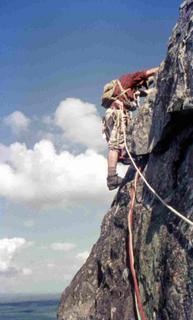 Tibrogargan's
Tibrogargan'sNortheast Buttress
Pat Conaghan (pictured) teamed with Grahame Hardy in the Glasshouses to force a new route up Tibrogargan’s huge, bare Northeast Buttress in October 1964 — at more than 250 metres, it was the longest climb on the mountain. The climb was one of Conaghan’s first on local rock since he and Ron Cox completed the traverse of Geryon in 1961. The first five pitches weave their way cunningly through a series of steep walls and overhangs, reaching a steep, smooth corner which splits the arete. Next the climb traverses out left onto bare, seamless rock and it was here that Conaghan resorted to bolts to climb the 10 metre crux. As a climb, it offers some airy and sensational positions and like many of the multi-pitch routes on Tibrogargan, requires a high level of route-finding skill. A young Ted Cais joined Conaghan for the second ascent of the route along with chemistry honours student, John Tillack. With a strong southeasterly wind blowing the occasional rain squall in from the sea, the trio started their climb up sometimes greasy rock, reaching a tiny ledge, where Cais takes up the story:
Before we had time to re-arrange the ropes the rain really hit us. Right out to sea was just one big haze, and quite soon, there wasn’t a dry square inch of rock around us. We grimly hung onto the rope handrail trying to find a comfortable position on that confounded ledge, sheltering under our one leaky anorak while discussing the big question: should we go down or up?The rain eventually stopped and a cutting wind added to their discomfort but it at least began to dry off the rock. They decided to climb on, with just three pitches remaining. Conaghan led off at 4.00 pm, reaching a small ledge, tantalisingly close to the next belay bolt, but separated from it by a greasy traverse. He decided to place another bolt for protection and 20 minutes went by as he patiently drilled—hit-twist; hit-twist; hit-twist. By the time he had reached the stance and belayed up Cais and Tillack, it was almost dark as even darker rain clouds raced towards them from Moreton Bay:
As I belayed him from the new bolt, Pat led up in the darkness with our only torch gripped firmly between his teeth, since there was no provision for tying the torch onto his waistlength. The slippery rock soon stopped his progress, however, and he found it necessary to place a new bolt, in attempting to reach a higher one from the first ascent which had served both as a runner and an anchor for a delicate tension traverse to the left. Time passed, and soon it was pitch black; not a start could be seen in the inly vault above our heads. I looked down to the Bruce Highway, where we could see the lights of cars that passed, their occupants being oblivious of the struggle we were having up on this rainswept cliff. Eventually Pat had the bolt in, and having then reached the higher bolt, he set out on the tension traverse. Groping for holds in the feeble light of the torch, at realised that he was going to come off. I heard him mumble something with the torch still in his mouth, and then he came off. The trusty bolt held and Pat fetched up a few feet above John and me. Conaghan came off again, realising he would have to bolt his way across this impasse. He set two more bolts and reached the belay stance, a very welcome tree.They stumbled, exhausted, onto the northeast shoulder at midnight. Descent in the dark without a torch was impossible but they managed to find a rock shelter where they shivered until dawn.
Picture: Pat Conaghan collection.
No comments:
Post a Comment